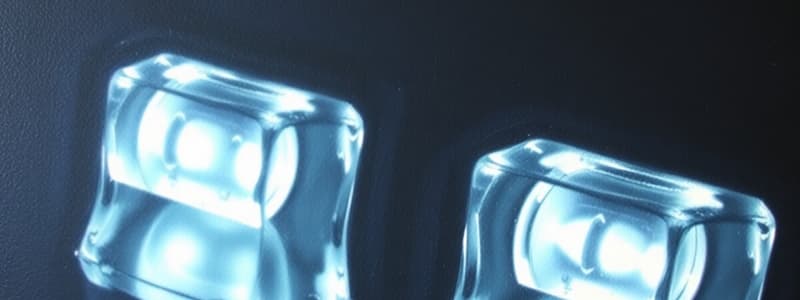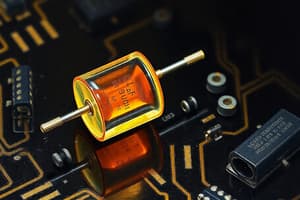Podcast
Questions and Answers
Which of the following best describes the function of a diode?
Which of the following best describes the function of a diode?
- To amplify electrical signals.
- To store electrical energy.
- To allow current flow predominantly in one direction. (correct)
- To regulate voltage in a circuit.
A diode is a three-terminal electronic component.
A diode is a three-terminal electronic component.
False (B)
What is the name given to the boundary between the n-type and p-type semiconductor material in a diode?
What is the name given to the boundary between the n-type and p-type semiconductor material in a diode?
pn junction
A diode has ______ resistance to current in one direction and high resistance in the other.
A diode has ______ resistance to current in one direction and high resistance in the other.
Match the biasing condition of a diode to its effect on current flow:
Match the biasing condition of a diode to its effect on current flow:
Prior to the use of semiconductor diodes, which electronic component was commonly used but suffered from being bulky and slow to start?
Prior to the use of semiconductor diodes, which electronic component was commonly used but suffered from being bulky and slow to start?
A diode's current-voltage characteristic is linear, similar to a resistor.
A diode's current-voltage characteristic is linear, similar to a resistor.
What is the most common application of diodes?
What is the most common application of diodes?
The region in a diode where no current flows is known as the ______ region.
The region in a diode where no current flows is known as the ______ region.
Match each diode terminal with its corresponding type of semiconductor material.
Match each diode terminal with its corresponding type of semiconductor material.
The arrow-like circuit symbol of a diode indicates:
The arrow-like circuit symbol of a diode indicates:
Applying a reverse bias voltage to a diode makes it conduct more current.
Applying a reverse bias voltage to a diode makes it conduct more current.
In an ideal diode, what is the voltage drop when it is conducting in the forward direction?
In an ideal diode, what is the voltage drop when it is conducting in the forward direction?
In the reverse direction, an ideal diode acts as an ______ circuit.
In the reverse direction, an ideal diode acts as an ______ circuit.
Match each circuit condition with its representation in the ideal diode model.
Match each circuit condition with its representation in the ideal diode model.
What determines whether none, one, or both diodes are conducting in a diode logic gate circuit?
What determines whether none, one, or both diodes are conducting in a diode logic gate circuit?
When analyzing a diode circuit, it is not necessary to make assumptions about the diode's conducting state.
When analyzing a diode circuit, it is not necessary to make assumptions about the diode's conducting state.
In a real diode, is the forward voltage drop exactly zero?
In a real diode, is the forward voltage drop exactly zero?
In the I-V characteristic of a real diode, the region where voltage is negative and current is ideally zero is called the ______-bias region.
In the I-V characteristic of a real diode, the region where voltage is negative and current is ideally zero is called the ______-bias region.
Match the region in the I-V characteristic curve of a real diode with its corresponding voltage condition:
Match the region in the I-V characteristic curve of a real diode with its corresponding voltage condition:
Which equation describes the relationship between current and voltage in a real diode?
Which equation describes the relationship between current and voltage in a real diode?
The saturation current ($I_s$) in a diode is independent of temperature.
The saturation current ($I_s$) in a diode is independent of temperature.
What is the typical value for the 'turn-on voltage' of a silicon diode?
What is the typical value for the 'turn-on voltage' of a silicon diode?
For a decade change in current in a diode, the voltage drop changes by approximately ______ mV (for n=1).
For a decade change in current in a diode, the voltage drop changes by approximately ______ mV (for n=1).
Match each diode parameter with its approximate value for a silicon diode:
Match each diode parameter with its approximate value for a silicon diode:
Which of the following is NOT a diode circuit model used for diode analysis?
Which of the following is NOT a diode circuit model used for diode analysis?
The piecewise linear model simplifies diode behavior by approximating it with linear segments.
The piecewise linear model simplifies diode behavior by approximating it with linear segments.
In the constant-voltage-drop model, what is assumed about the voltage across a forward-biased conducting diode?
In the constant-voltage-drop model, what is assumed about the voltage across a forward-biased conducting diode?
The constant voltage drop model assumes that once a diode is forward biased, the voltage drop across it is ______.
The constant voltage drop model assumes that once a diode is forward biased, the voltage drop across it is ______.
Match each diode characteristic with its corresponding representation in the piecewise-linear model:
Match each diode characteristic with its corresponding representation in the piecewise-linear model:
When testing a diode with an ohmmeter, what reading would indicate a forward-biased diode?
When testing a diode with an ohmmeter, what reading would indicate a forward-biased diode?
When testing a diode with an ohmmeter, infinite resistance indicates a reverse-biased diode.
When testing a diode with an ohmmeter, infinite resistance indicates a reverse-biased diode.
What is the name given to the type of diode that is optimized for speed and used in low current and switching applications?
What is the name given to the type of diode that is optimized for speed and used in low current and switching applications?
Diodes designed to conduct in the reverse direction with a precise breakdown voltage are called ______ diodes.
Diodes designed to conduct in the reverse direction with a precise breakdown voltage are called ______ diodes.
Match each diode type with its primary application:
Match each diode type with its primary application:
What is the main difference between a standard diode and a Light-Emitting Diode (LED)?
What is the main difference between a standard diode and a Light-Emitting Diode (LED)?
LEDs typically have a lower voltage drop than standard silicon diodes.
LEDs typically have a lower voltage drop than standard silicon diodes.
What is emitted when an electron flows through a light-emitting diode (LED)?
What is emitted when an electron flows through a light-emitting diode (LED)?
LEDs require a current-limiting ______ when used in a circuit.
LEDs require a current-limiting ______ when used in a circuit.
Match each application of a diode circuit with its function:
Match each application of a diode circuit with its function:
Flashcards
What is a diode?
What is a diode?
Two-terminal electronic component with asymmetric conductance; low resistance in one direction, high in the other.
What is a diode?
What is a diode?
The diode is the simplest and most fundamental nonlinear circuit element with two terminals.
What is a p-n junction diode?
What is a p-n junction diode?
Formed when a p-type semiconductor is doped on one side and an n-type impurity is doped on the other side of a single crystal.
What is the I-V characteristic of a diode?
What is the I-V characteristic of a diode?
Signup and view all the flashcards
What is the Ideal Diode?
What is the Ideal Diode?
Signup and view all the flashcards
What is turn-on voltage?
What is turn-on voltage?
Signup and view all the flashcards
Why is rapid circuit analysis needed in design process?
Why is rapid circuit analysis needed in design process?
Signup and view all the flashcards
What is the Piecewise-Linear model?
What is the Piecewise-Linear model?
Signup and view all the flashcards
What is the Constant-Voltage-Drop model?
What is the Constant-Voltage-Drop model?
Signup and view all the flashcards
What are rectifier diodes?
What are rectifier diodes?
Signup and view all the flashcards
What are signal diodes?
What are signal diodes?
Signup and view all the flashcards
What are zener diodes?
What are zener diodes?
Signup and view all the flashcards
What is a light-emitting diode (LED)?
What is a light-emitting diode (LED)?
Signup and view all the flashcards
Study Notes
- Diode Fundamentals are explained
- Lectures by Prof. Francis Kofi Ampong, Senior Lecturer, Dept. of Physics, University of Science & Technology, Kumasi
Topics Covered
- Introduction to diodes
- Ideal diode
- Real diode
- Diode analyses (diode models)
- Special types of p-n Junction Semiconductor Diodes
- Applications of Diodes
Introduction to Diodes
- A wide range of electronic devices can be traced back to the p-n junction diode
- The p-n junction diode is formed by doping a p-type semiconductor impurity on one side and an n-type impurity on the other side of a single crystal
- Macro effects of electronic devices, like wave shaping and amplifying, occur at the junction of the p-n device
- Modern devices often modify or combine p-n devices
- Semiconductor diodes and allied junction devices solved issues of bulk, cost, and slow start-up times of vacuum tubes
- Diodes are the simplest and fundamental nonlinear circuit element
- Diodes have two terminals, similar to resistors
- Unlike resistors, diodes exhibit nonlinear current-voltage characteristics
- Rectifiers constitute the most common application for diodes
- The pn junction is the most important region, as it is the boundary between n-type and p-type semiconductors
Diode Characteristics
- A diode is a two-terminal electronic component with asymmetric conductance
- It has low resistance to current in one direction and high resistance in the other
- The most common function is to allow electric current to pass in one direction while blocking it in the opposite direction
- Conducting in one direction and not in the other forms the I-V characteristic
- The arrow-like circuit symbol indicates the direction of conducting current
- Forward biasing voltage turns the diode on
- Reverse biasing voltage turns the diode off
Ideal Diode
- The ideal diode has specific current-voltage characteristics
- In the two modes of operation, an external circuit is used to limit the forward current and the reverse voltage
Real Diode I-V Characteristics
- Includes a graph depicting the I-V characteristics of a real diode, with considerations for forward and reverse bias, as well as breakdown voltage
- The forward-bias region is determined by v > 0
- The reverse-bias region is determined by -VZK < v < 0
- The breakdown region is determined by v < -VZK
p-n Junction Under Forward-Bias
- Includes the Shockley diode equation: ID = Is(e^(qVD/nkT) - 1)
- i = Is (e^(v/nVT) - 1)
- VT = kT/q
- The equation displays an exponential relationship with nonlinear characteristics
- Is is the saturation current and depends strongly on temperature
- n is a value of 1 or 2
- VT is thermal voltage
- For significant current in the forward direction (i >> Is), the equation simplifies to v = nVT ln(i/Is)
- For a decade change in current, the diode voltage changes by approximately 60mV (for n=1) or 120mV (for n=2)
- Turn-on voltage is approximately constant - silicon: 0.7V, germanium: 0.25V
Diode Analyses: Diode Models
- Piece wise linear model
- The constant-voltage-drop model
- Iterative analysis
Piecewise-Linear Model
- iD = 0, vD ≤ VD0, iD = (vD - VD0) / rD , vD ≥ VD0
- VDO is the intercept of the line B on the voltage axis and rD is the inverse of the slope of line B
Constant-Voltage-Drop Model
- VD = 0.7 V is a constant voltage drop
Studying That Suits You
Use AI to generate personalized quizzes and flashcards to suit your learning preferences.




